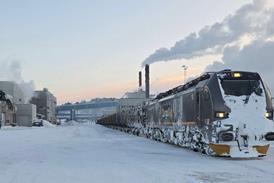Revenue services were launched on a 20 km section of Mexico City's first purpose-built suburban railway on June 2, following three weeks of fare-free trial operation with passengers.
Known locally as El Tren Suburbano, the line links the capital's former inter-city terminus at Buenavista with Cuautitlán in the north, using an existing right-of-way that has been upgraded and electrified. A 30-year turnkey concession to rebuild, operate and maintain the line was awarded in August 2005 to a consortium led by CAF of Spain; this is valued at US$660m.
CAF has supplied an initial fleet of 20 three-car EMUs, based on its Class 447 design supplied to Spanish national rail operator RENFE. These air-conditioned sets have two driving motor cars and an intermediate trailer, but have been designed to be expanded to four-car formations as traffic builds up. The line is electrifed at 25 kV 50 Hz.
Public services are initially operating over the 20 km section of the route between Buenavista and Lechería, serving three intermediate stations at Fortuna, Tlalnepantla and San Rafael; the remaining 7 km to Tultitlán and Cuautitlán is expected to open later this year. Interchange is provided with metro Line B at Buenavista and Line 6 at Fortuna.
Peak-hour trains will run every six minutes, with an end-to-end journey time of 23 min; this represents a saving of an hour or more compared to buses on the parallel highway. When the route is fully operational it will have a capacity of 30 000 passengers/h in each direction, and officials expect it could eventually be carry 100 million passengers a year.
The concession includes provisions for a 21 km extension from Cuautitlán to Huehuetoca, on which work is expected to start later this year, plus branches from Lechería to Jaltocan and San Rafael to Tacuba, bringing the network to 79 km. Further suburban railway projects are also being developed to serve other parts of the Mexico City conurbation, with suggestions that the total network could eventually reach 242 route-km.
Read more about the project in the March 2008 issue of Metro Report International

















